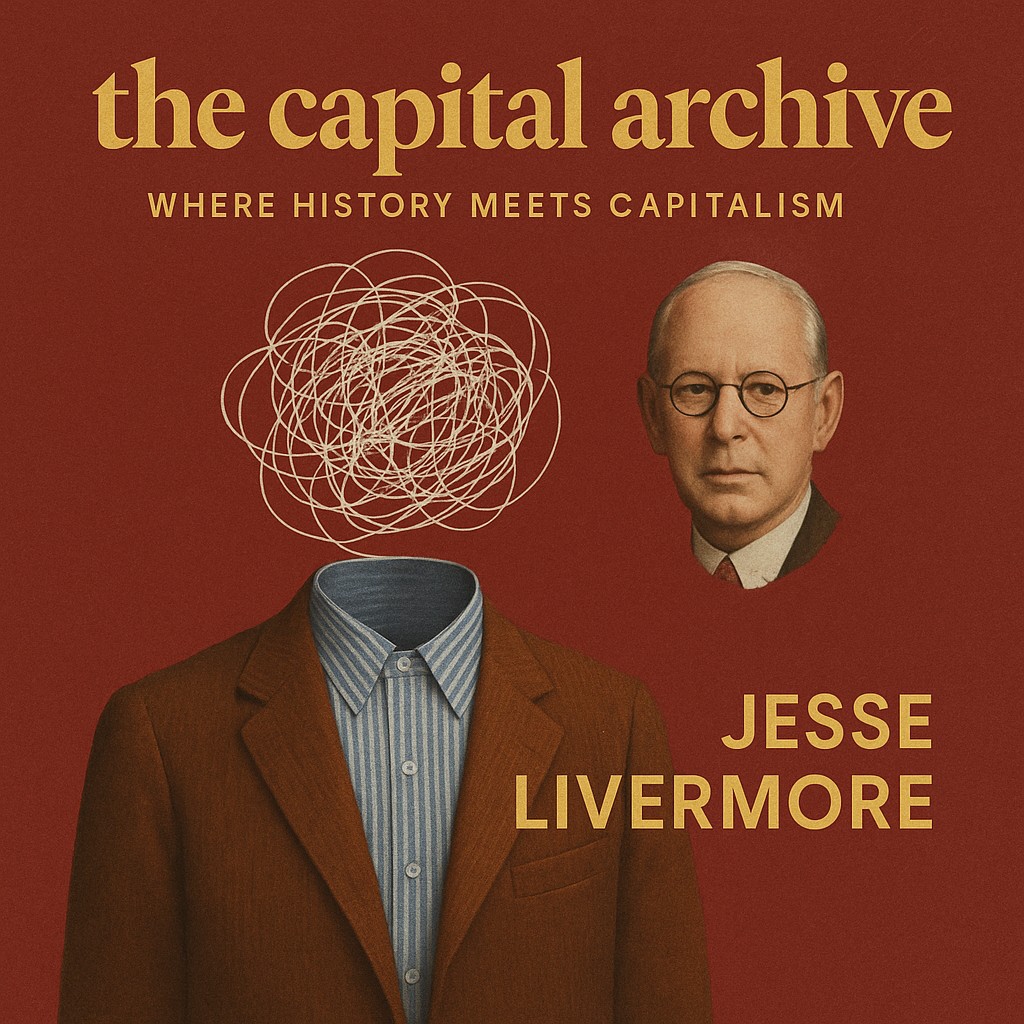Few names in financial history evoke as much fascination—and caution—as Jesse Livermore. Known as the “Boy Plunger” and immortalized in the classic Reminiscences of a Stock Operator, Livermore’s life reads like a rollercoaster through the peaks and valleys of early 20th-century finance. In this episode of The Capital Archive, we dive into the true story behind the myth: from humble beginnings and spectacular market triumphs to devastating losses and personal tragedy.
From Chalk Boy to Market Maverick
Born in 1877 in rural Massachusetts, Jesse Livermore’s early life was marked by hardship and precocious intellect. By age 14, he had left home with just five dollars, determined to escape a life of farming. He quickly found work as a chalkboard boy at Paine Webber, where he updated stock prices for customers and began to notice patterns in price movements that others missed. Livermore’s keen observations and mathematical mind set him apart, and he started recording his theories in a notebook—laying the groundwork for his future trading strategies.
The Bucket Shop Years: Where Legends Are Made
Unable to afford the minimums required by traditional brokers, Livermore turned to bucket shops—a hybrid of bookmaker and brokerage—where small bets could be placed on stock price movements. Here, he honed his skills, turning a $5 trade into a 62% profit at just 15 years old. His consistent winnings soon led to bans from every bucket shop in Boston, forcing him to don disguises and eventually take his talents on the road. By 16, he had made the equivalent of a quarter-million dollars in today’s money, earning the nickname “the Boy Plunger” for his bold, leveraged bets.
Lessons on Wall Street: Triumphs and Turmoil
Livermore’s transition to the New York Stock Exchange was not smooth. The tactics that worked in bucket shops failed in the real market, where his trades themselves moved prices. After a string of losses and a failed marriage, he regrouped, analyzing his mistakes and refining his approach. He learned to trade less frequently, focus on larger market trends, and ignore market “tips”—a discipline that would later define his career.
His big break came during the Panic of 1907, when his short positions netted him millions. J.P. Morgan himself intervened, asking Livermore to stop short selling to help stabilize the market—a testament to Livermore’s influence at the time. Yet, as quickly as he built fortunes, Livermore lost them, often due to emotional decision-making or breaking his own trading rules.
Booms, Busts, and Personal Demons
Livermore’s life outside the market was equally dramatic. He lived lavishly, married showgirls, and collected mansions, yachts, and guns. But his successes were punctuated by spectacular failures, including bankruptcy, family turmoil, and personal tragedy. His second marriage ended in scandal and financial ruin, and his children struggled with their own demons.
The introduction of new regulations in the 1930s, including the formation of the SEC, outlawed many of Livermore’s trading tactics. By 1934, he was bankrupt again, and his influence on Wall Street waned. His final years were marked by depression and isolation, culminating in his suicide in 1940. His estate, once worth millions, was left with more debts than assets.
Legacy: Genius, Cautionary Tale, or Both?
Jesse Livermore’s story is both an inspiration and a warning. He pioneered techniques in timing, money management, and trend-following that remain relevant to traders today. Yet, his life underscores the dangers of leverage, emotional trading, and the psychological toll of the markets.
“The hope of forcing the stock market to pay your bills is one of the most prolific sources of loss on Wall Street.” — Jesse Livermore
His book How to Trade in Stocks is now in the public domain, offering insight into his thinking for anyone willing to study it. But as his own life shows, no system is foolproof, and the line between luck and skill is often blurred.
Key Takeaways for Modern Traders
- Discipline is everything: Livermore’s greatest successes came when he followed his rules; his biggest losses when he broke them.
- Adaptability matters: Markets change, and so must strategies. Livermore’s ability to learn from mistakes was crucial to his comebacks.
- Emotional resilience is critical: The psychological strain of trading can be immense—a lesson Livermore learned at great personal cost.
- Don’t blindly follow legends: While Livermore’s principles are still studied, they must be tested and adapted for today’s markets.
Livermore’s life is a testament to the heights and depths possible in trading. His story continues to captivate and caution, reminding us that behind every legend is a complex, very human tale.
For a deeper dive, listen to the full episode and explore the real lessons behind the legend of Jesse Livermore.


